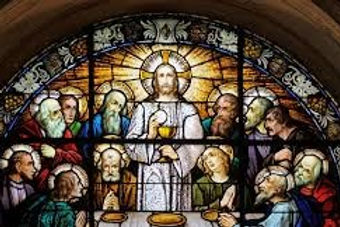A Welcoming Community of Faith Rooted in the Catholic Tradition.
Consecrated July 7, 1997
Our Liturgical Life

Desplácese hacia abajo para ver la traducción al español
Ecumenically speaking public worship is a common practice in most major religions enabling their members to grow in their faith tradition and to build stronger connections within their jurisdictions.
For us within the Evangelical Catholic Church our public worship is commonly known as liturgy, which comes from the Greek word leitourgia, which mean “work for the people.”
The whole liturgical life of the Evangelical Catholic Church revolves around the Eucharistic sacrifice and the sacraments. There are seven sacraments in the Church: Baptism, Confirmation, Eucharist, Penance, Anointing of the Sick, Holy Orders, and Matrimony.
The liturgy is public, communal worship that praises God. The term refers to the collective rites, ceremonies, prayers, and sacraments of the Catholic Church and is a celebration of the Paschal Mystery — that is, the mystery of Christ’s passion, death, resurrection, and ascension, and God’s plan for eternal salvation.
Our Church's liturgical year consists of five key seasons: Advent, Christmas, Ordinary Time, Lent, and Easter. These seasons mark the Church's celebration of Jesus' life, death, and resurrection, as well as the Holy Spirit's arrival.
Here's a more detailed look at each season:
1. Advent: This is the four-week period before Christmas, a time of preparation for the coming of Christ. It's a time of reflection, prayer, and spiritual renewal, as Catholics await the birth of Jesus.
2. Christmas: This season celebrates the birth of Jesus Christ, the Son of God, marking the beginning of the Christian faith. It's a time of joy and celebration, often associated with gifts, family gatherings, and special liturgical celebrations.
3. Ordinary Time: This season occupies most of the year and is divided into two periods: the time after Epiphany and the time after Pentecost. It's a time of regular liturgical readings, focusing on the Gospels and the teachings of Jesus.
4. Lent: This six-week period leading up to Easter is a time of penitence, prayer, fasting, and almsgiving. It's a time for Catholics to reflect on their sins, strengthen their faith, and prepare for the celebration of Christ's resurrection.
5. Easter: This season celebrates Jesus' resurrection from the dead, his victory over death, and his ascension into heaven. It's a time of great joy and thanksgiving, often associated with special liturgical celebrations, family gatherings, and traditional foods.

Liturgy is also intended to be a constant dialogue of love between the three persons of the Holy Trinity: the Father, the Son, and the Holy Spirit.
In the Evangelical Catholic Church, the Mass — the central liturgical service — is comprised of two principal parts: the Liturgy of the Word, which consists of readings from Scripture, and the Liturgy of the Eucharist, which consists in the breaking of the bread as a remembrance of Jesus’ Last Supper. Participants in our liturgies believe that Christ is present in the liturgy through the person of the minister, the assembled people of God, the Word of God, and in the consecrated bread and wine of the Eucharist.
For the Evangelical Catholic Church, the "Novus Ordo" is the Mass we celebrate. The Novis Ordo was promulgated / established by Paul VI in 1969, essentially retiring the Tridentine Mass. The Novus Ordo is celebrated in the local language and with the priest facing the people.
The liturgy of the Evangelical Catholic Church then is rightly seen as an exercise of the priestly office of Jesus Christ. It involves the presentation of humanities sanctification under the guise of signs perceptible by the senses and its accomplishment in ways appropriate to each of these signs. In it full public worship is performed by the Mystical Body of Jesus Christ, that is, by the Head and his members. From this it follows that every liturgical celebration, because it is an action of Christ the priest and of his Body which is the Church, is a sacred action surpassing all others. No other action of the Church can equal its efficacy by the same title and to the same degree.
Please remember that when you share in the liturgical life of the Evangelical Catholic Church your life will be enriched these important functions of our celebration of the liturgy:
Giving glory and honor to God
Imparting the wisdom of Christ’s teachings
Creating a sacred space to explore the Paschal Mystery
Drawing people into the Word of God
Empowering parishioners to engage with their faith and deepen their relationships with God and one another.
Together as a Welcoming Community of Faith Rooted in the Catholic Tradition, let us “Set the World on Fire.”
Thank you for taking the time to read and reflect on this information.
If you have any questions about the liturgical life of the Evangelical Catholic Church, please do not hesitate to share them with us.
You may wish to visit and read these related pages:
“A Welcoming Community of Faith Rooted in the Catholic Tradition”
©2025

Nuestra vida litúrgica
Ecuménicamente hablando, el culto público es una práctica común en la mayoría de las religiones principales, lo que permite a sus miembros crecer en su tradición de fe y construir conexiones más fuertes dentro de sus jurisdicciones.
Para nosotros dentro de la Iglesia Católica Evangélica nuestro culto público se conoce comúnmente como liturgia, que proviene de la palabra griega leitourgia, que significa “trabajo para el pueblo”.
Toda la vida litúrgica de la Iglesia Católica Evangélica gira en torno al sacrificio eucarístico y los sacramentos. Hay siete sacramentos en la Iglesia: Bautismo, Confirmación, Eucaristía, Penitencia, Unción de los Enfermos, Orden Sacerdotal y Matrimonio. de la pasión, muerte, resurrección y ascensión de Cristo, y el plan de Dios para la salvación eterna.
La liturgia es el culto público y comunitario que alaba a Dios. El término se refiere a los ritos, ceremonias, oraciones y sacramentos colectivos de la Iglesia Católica y es una celebración del Misterio Pascual, es decir, el misterio de la pasión, muerte, resurrección y ascensión de Cristo, y el plan de Dios para la salvación eterna.
El año litúrgico de nuestra Iglesia consta de cinco tiempos clave: Adviento, Navidad, Tiempo Ordinario, Cuaresma y Pascua. Estos tiempos marcan la celebración de la Iglesia de la vida, muerte y resurrección de Jesús, así como de la venida del Espíritu Santo.
A continuación, un análisis más detallado de cada tiempo:
1. Adviento: Este es el período de cuatro semanas antes de Navidad, un tiempo de preparación para la venida de Cristo. Es un tiempo de reflexión, oración y renovación espiritual, mientras los católicos esperan el nacimiento de Jesús.
2. Navidad: Esta época celebra el nacimiento de Jesucristo, el Hijo de Dios, lo que marca el inicio de la fe cristiana. Es un tiempo de alegría y celebración, a menudo asociado con regalos, reuniones familiares y celebraciones litúrgicas especiales.
3. Tiempo Ordinario: Este tiempo ocupa la mayor parte del año y se divide en dos períodos: el tiempo después de Epifanía y el tiempo después de Pentecostés. Es un tiempo de lecturas litúrgicas regulares, centradas en los Evangelios y las enseñanzas de Jesús.
4. Cuaresma: Este período de seis semanas previo a la Pascua es un tiempo de penitencia, oración, ayuno y limosna. Es un tiempo para que los católicos reflexionen sobre sus pecados, fortalezcan su fe y se preparen para la celebración de la resurrección de Cristo.
5. Pascua: Esta época celebra la resurrección de Jesús, su victoria sobre la muerte y su ascensión al cielo. Es un tiempo de gran alegría y agradecimiento, a menudo acompañado de celebraciones litúrgicas especiales, reuniones familiares y comidas tradicionales.

La liturgia también quiere ser un diálogo constante de amor entre las tres personas de la Santísima Trinidad: el Padre, el Hijo y el Espíritu Santo.
En la Iglesia Católica Evangélica, la Misa —el servicio litúrgico central— se compone de dos partes principales: la Liturgia de la Palabra, que consiste en lecturas de las Escrituras, y la Liturgia de la Eucaristía, que consiste en la fracción del pan como recuerdo de la Última Cena de Jesús. Quienes participan en nuestras liturgias creen que Cristo está presente en la liturgia a través de la persona del ministro, el pueblo de Dios reunido, la Palabra de Dios y en el pan y el vino consagrados de la Eucaristía.
Para la Iglesia Católica Evangélica, el Novus Ordo es la misa que celebramos. El Novis Ordo fue promulgado/establecido por Pablo VI en 1969, esencialmente retirando la misa tridentina. El Novus Ordo se celebra en el idioma local y con el sacerdote de cara al pueblo.
La liturgia de la Iglesia Católica Evangélica se considera, pues, con razón, un ejercicio del oficio sacerdotal de Jesucristo. Implica la presentación de la santificación de las humanidades mediante signos perceptibles por los sentidos y su cumplimiento de maneras apropiadas a cada uno de estos signos. En ella, el culto público pleno es realizado por el Cuerpo Místico de Jesucristo, es decir, por la Cabeza y sus miembros. De ello se desprende que toda celebración litúrgica, por ser una acción de Cristo sacerdote y de su Cuerpo, que es la Iglesia, es una acción sagrada superior a todas las demás. Ninguna otra acción de la Iglesia puede igualar su eficacia con el mismo título y en el mismo grado.
Por favor recuerda que cuando compartes la vida litúrgica de la Iglesia Católica Evangélica tu vida se verá enriquecida por estas importantes funciones de nuestra celebración de la liturgia:
Dando gloria y honor a Dios
Compartiendo la sabiduría de las enseñanzas de Cristo
Creando un espacio sagrado para explorar el Misterio Pascual
Atrayendo a la gente a la Palabra de Dios
Empoderando a los feligreses para que se adentren en su fe y profundicen su relación con Dios y entre sí.
Juntos, como una acogedora comunidad de fe arraigada en la tradición católica, “Enciendamos el mundo”.
Gracias por tomarse el tiempo de leer y reflexionar sobre esta información.
Si tiene alguna pregunta sobre la vida litúrgica de la Iglesia Católica Evangélica, no dude en compartirla con nosotros.
“Una comunidad de fe acogedora arraigada en la tradición católica”
©2025